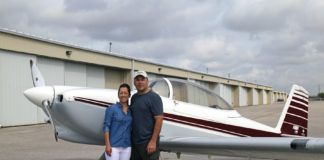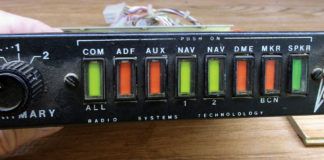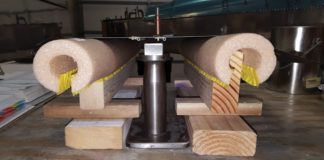Starter Sauce
Regarding Amy Labodas experience with the purge valve in her RV-10, I also use an Airflow Performance experimental fuel-injection system on the IO-360-B1B engine mounted in my RV-7A. I love the purge valve! It all involves knowing how to use it. I use the following procedure to build a fire under the cowl:
1. Purge valve pulled back (thats open). Mixture lean.
2. Boost pump on for 2 minutes to circulate cool fuel from the fuel tank through the system and back to the tank. Boost pump off. Note: This step is not needed if the engine is cold, but I do it anyway to remove any possible bubbles.
3. Purge valve pushed forward (closed). Mixture rich. Throttle full.
4. Boost pump on for 5 seconds: one thousand one, one thousand two… one thousand five. Boost pump off. Mixture lean. The engine is now flooded.
5. Spin the starter while slowly retarding the throttle. This has to be slow or you will pass the start-mixture point.
6. When the engine coughs and spits the mixture is almost correct. Schooch the throttle in a bit to keep the fire lit, and push the mixture to full rich (requires two right hands).
7. Presto, the engine is running.
Amy, this works so well that I use it all the time, even when the engine is cold. Other unknowing pilots have a heart attack when they see me purposely flood the engine and then are amazed when it fires right off.
Bob Pittelkow
While this clearly works for you, Bob, be careful about over-priming. That avgas will just wash the cylinder walls of lubrication and pollute the oil. Use just enough fuel to get it started. The way it works for me, with an Airflow-equipped IO-390, is to prime less (a count of three at most), leave the boost pump running, crank with one turn of throttle and the purge valve closed. When the engine coughs, advance the purge valve knob to the run position. Works 99 times out of 100. Also, there’s no reason to leave the mixture lean when purging, which, for those unfamiliar, uses a bypass valve just ahead of the spider; when bypassing, fuel can travel through the system but does not enter the cylinders. All that does is restrict fuel flow through the system; you want to move as much fuel as you can to cool the lines. I purge with throttle and mixture full in.-Ed.
Can You Hear Me Now?
I wanted to tell you how much I enjoyed the article by Sam Buchanan on APRS in the August issue of KITPLANES. I enjoyed it so much, I immediately started studying for the Technician class ham license. I took the test in Santa Maria, California, after taking the online tests Sam referenced and passed easily. I look forward to trying out this neat option in my Thorp. Thanks for a great article!
Tom Hunter
IFR Requirements for Homebuilts
I enjoyed your article, Steam Gauge Special, in the August issue. I am building a Bearhawk and plan to use almost exactly the same minimal IFR setup you did with a steam gauge six-pack, Garmin 496, Garmin 300XL, Garmin 327, and Val 422, plus a TruTrak Pictorial Pilot. I assume the panel in one of the pictures was your panel, with a Pictorial Pilot in the usual position of a turn coordinator. This is what I want to do but have wondered if the FAA will accept the non-TSOd Pictorial Pilot as a substitute for a TSOd turn coordinator in a homebuilt approved for IFR. Or will they make me put in a TSOd turn and bank or turn coordinator to get IFR approval?
Rex Ervin
Stein responds: The FAA actually has nothing to do with the IFR Approval of a homebuilt. It is your responsibility to deem the aircraft IFR capable. When your airworthiness certificate is issued and you receive your operating limitations, you’ll find a statement in there that basically says if you intend to fly the aircraft IFR, you must ensure all appropriate equipment is installed. After your Phase I test period, if you have the appropriate instrumentation for the type of IFR flying you will be doing, you may fly the aircraft IFR. Aside from the transponder and possibly GPS (but only if you intend to fly IFR GPS approaches), there are literally no other limitations on what must be TSOd. IFR-approved equipment (en route, terminal or approach) must be installed according to the manufacturers instructions, and is by definition TSO approved.
Jabiru Feedback
Im sorry that Bob Fritz didn’t receive the excellent Jabiru kit that we did. We feel that the Jabiru 250 is a great airplane, actually the best of type. The quality exceeded my expectations, especially the manner in which the kit was received. Were the instructions perfect? No, but the product showed improvements on the items that differed from the instructions. Would I recommend that others buy and fly the Jabiru 250? Unequivocally the answer is yes. The Jabiru 3300 is a finely tuned engine that I really feel comfortable flying, as it is so smooth and responsive. My only initial concern was that the 3300 engine doesn’t use much oil during break-in, but I would guess that it has been produced to tight specifications.
I really enjoy Bob Fritzs writing and feel sorry that his kit didn’t meet his expectations, but I would hope that Bobs project, when completed to the perfect level that he aspires to, will be a huge plus for the Jabiru kit.
Really look forward to each issue of KITPLANES magazine. Dick Sleeper




